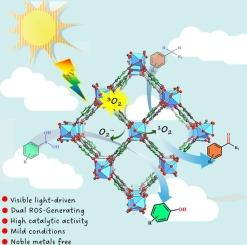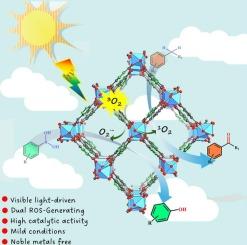Visible-light-driven aerobic oxidation via a dual ROS-generating manganese(II)-organic framework photocatalyst
IF 6.5
1区 化学
Q2 CHEMISTRY, PHYSICAL
引用次数: 0
Abstract
Developing sustainable and efficient photocatalytic systems for aerobic oxidation remains a pivotal challenge in green chemistry. Herein, we report the rational design and synthesis of a novel manganese(II)-organic framework (An-MnMOF) by integrating anthracene-based photoactive ligands with Mn(II)-oxo clusters. The framework exhibits broad visible-light absorption extending up to 650 nm, efficient charge separation, and dual reactive oxygen species (ROS) generation capabilities. Structural characterization confirms a crystalline 2D lamellar architecture with hierarchical porosity, while mechanistic studies reveal a synergistic interplay between anthracene-mediated light harvesting and Mn(II)-driven redox processes. Under visible-light irradiation, An-MnMOF achieves exceptional catalytic performance in aerobic oxidation reactions, including hydroxylation of arylboronic acids (>95 % yield) and benzylic C(sp3)-H bond activation (>85 % yield), outperforming the homogeneous Mn catalyst. The framework’s microporous channels stabilize reactive intermediates, suppressing overoxidation, while its robust chemical and thermal stability enables five consecutive recycling cycles without activity loss. This work establishes a paradigm for noble-metal-free photocatalysis by leveraging MOF-confined dual-function sites for solar-driven organic transformations, advancing sustainable synthesis methodologies.


通过双ros生成锰(II)-有机框架光催化剂的可见光驱动的好氧氧化
开发可持续、高效的有氧氧化光催化系统仍然是绿色化学的关键挑战。在此,我们报告了通过将蒽基光活性配体与Mn(II)-氧基团结合,合理设计和合成了一种新型锰(II)-有机骨架(An-MnMOF)。该框架具有广泛的可见光吸收,可达650 nm,有效的电荷分离和双活性氧(ROS)生成能力。结构表征证实了具有分层孔隙度的结晶二维层状结构,而机理研究揭示了蒽介导的光捕获和Mn(II)驱动的氧化还原过程之间的协同相互作用。在可见光照射下,An-MnMOF在好氧氧化反应中表现出优异的催化性能,包括芳基硼酸的羟基化(收率为>95 %)和苯基C(sp3)-氢键的活化(收率为>85 %),优于均相Mn催化剂。该框架的微孔通道稳定了活性中间体,抑制了过度氧化,同时其强大的化学和热稳定性使其能够连续循环5次而不损失活性。这项工作通过利用mof限制的双功能位点进行太阳能驱动的有机转化,建立了无贵金属光催化的范例,推进了可持续的合成方法。
本文章由计算机程序翻译,如有差异,请以英文原文为准。
求助全文
约1分钟内获得全文
求助全文
来源期刊

Journal of Catalysis
工程技术-工程:化工
CiteScore
12.30
自引率
5.50%
发文量
447
审稿时长
31 days
期刊介绍:
The Journal of Catalysis publishes scholarly articles on both heterogeneous and homogeneous catalysis, covering a wide range of chemical transformations. These include various types of catalysis, such as those mediated by photons, plasmons, and electrons. The focus of the studies is to understand the relationship between catalytic function and the underlying chemical properties of surfaces and metal complexes.
The articles in the journal offer innovative concepts and explore the synthesis and kinetics of inorganic solids and homogeneous complexes. Furthermore, they discuss spectroscopic techniques for characterizing catalysts, investigate the interaction of probes and reacting species with catalysts, and employ theoretical methods.
The research presented in the journal should have direct relevance to the field of catalytic processes, addressing either fundamental aspects or applications of catalysis.
 求助内容:
求助内容: 应助结果提醒方式:
应助结果提醒方式:


